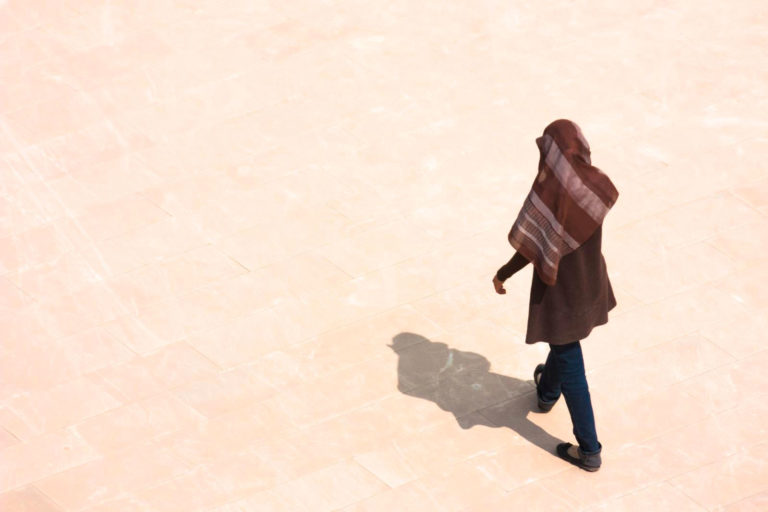
Image by Hectór de Pereda/Flickr, Attribution-NonCommercial.
The Seeking Woman at the Heart of a Pilgrimage
This month, millions of Muslims have gathered in Arabia for a once-in-a-lifetime pilgrimage: the hajj. They — we — have come from every background, every race, every class. The hajj has become something of a Rorschach test for Muslims and for the world: we see in it whatever we imagine about Islam and Muslims.
To so many, it is the ultimate symbol of Muslim unity, where white and black, yellow and brown skins stand shoulder-to-shoulder, united before the One. To others, it is a symbol of how the consumerist capitalist culture, symbolized by the high-rise luxury hotels over Mecca, have thwarted and distorted the radical egalitarianism of Islam. Some see a fabulous exchange of the richness of Muslim cultures, food, learning, and stories. Others see a chance to express geopolitical tensions.
There is a time and place for those ways of approaching the hajj, but I want to focus on a simpler truth. Every one of those pilgrims walks in the footsteps of a black woman, a maiden or a slave (depending on the story you prefer), a woman left in God’s care, or abandoned by a husband, a co-wife, or the victim of Sarah’s jealousy. Every pilgrim walks in the footsteps of our mother Hajar/Hagar, a noble, lone, tired, exhausted woman living as a single mother in the desert, without family, without support, without money, without water…
Death was close.
God was closer.
She clutched her son so close that he breathed the air she breathed. Her faith in God, and love for her baby, saved them both.
Hajar figures differently in the Bible than she does in the Qur’an, partially because of how differently Isaac and Ishmael fare in the two scriptures. The Bible is written by the descendants of Isaac. So Ishmael and his mother Hajar, “the stranger,” are cast out, sent out, exit stage left.
In the Qur’an, Isaac and Ishmael are both God’s prophets, both honored, both chosen by God. And both Sarah and Hajar are treated as wives of Abraham. Yet this much is agreed upon: Abraham left Hajar and Ishmael in the desert.
Here is how the story of Hajar is told in Martin Lings’ biography of Muhammad:
“It was not long before both mother and son were overcome by thirst, to the point that Hagar feared Ishmael was dying. According to the traditions of their descendants, he cried out to God from where he lay in the sand, and his mother stood on a rock at the foot of a nearby eminence to see if any help was in sight. Seeing no one, she hastened to another point of vantage, but from there likewise not a soul was to be seen.”
— Martin Lings, Muhammad: His Life Based on the Earliest Sources
During pilgrimage, all the pilgrims engage in a ritual called sa’y, where they rush between the hills of Safa and Marwa, quite literally tracing the footsteps of Hajar. So in this hajj, my heart and my attention go to Hajar, and go to walking in the footsteps of this woman cast aside and apart.
During this season of hajj, I find myself thinking of Hajar — yes, the quiet strength, the trust in God, but also the experience of being alone and even abandoned, even as she knows she cannot fall apart. How amazing that the hajj focuses on the experience of this black woman, not on some lofty maternal pedestal, but on the ground, running here and there, searching to provide for her baby. Going back to the biography of Muhammad, we read:
“Half distraught, she passed seven times in all between the two points, until at the end of her seventh course, as she sat for rest on the further rock, the Angel spoke to her. In the words of Genesis:
And God heard the voice of the lad; and the angel of God called to Hagar out of heaven and said to her: What aileth thee, Hagar? Fear not, for God hath heard the voice of the lad where he is. Arise and lift up the lad and hold him in thy hand, for I will make him a great nation. And God opened her eyes, and she saw a well of water,’
The water was a spring which God caused to well up from the sand at the touch of Ishmael’s heel; and thereafter the valley soon became a halt for caravans by reason of the excellence and abundance of the water; and the well was named Zamzam.”
All the pilgrims on hajj today seek to drink the waters of Zamzam that still gush in Mecca. Thousands of years later, the seeking of Hajar still quenches our thirst.
We walk in her footsteps, but I wonder — do we identify with the experience of women? Of black women? Of abandoned single women? Of single mothers?
Let us look for the Hajars in our midst, and in our own hearts.
The poem “The Fire of Hajar” by Mohja Kahf that speaks to me.
The pilgrims come, and they return home. We talk about Hajar and the season passes.
I wonder, I wonder, how we stand with all the single moms, the black women, the abandoned ones, the lonely and marginalized, running here, running there, trusting none but God. I wonder about the Hajars among us, and the babies. I wonder if we will remember Hajar after the pilgrims have returned home.
It is Hajar’s tears, her walking, her seeking, and her faith that bless a whole community. I wonder if we as the community know whose steps we follow, whose seeking has brought out the gushing fountain that sustains us all.


Share your reflection